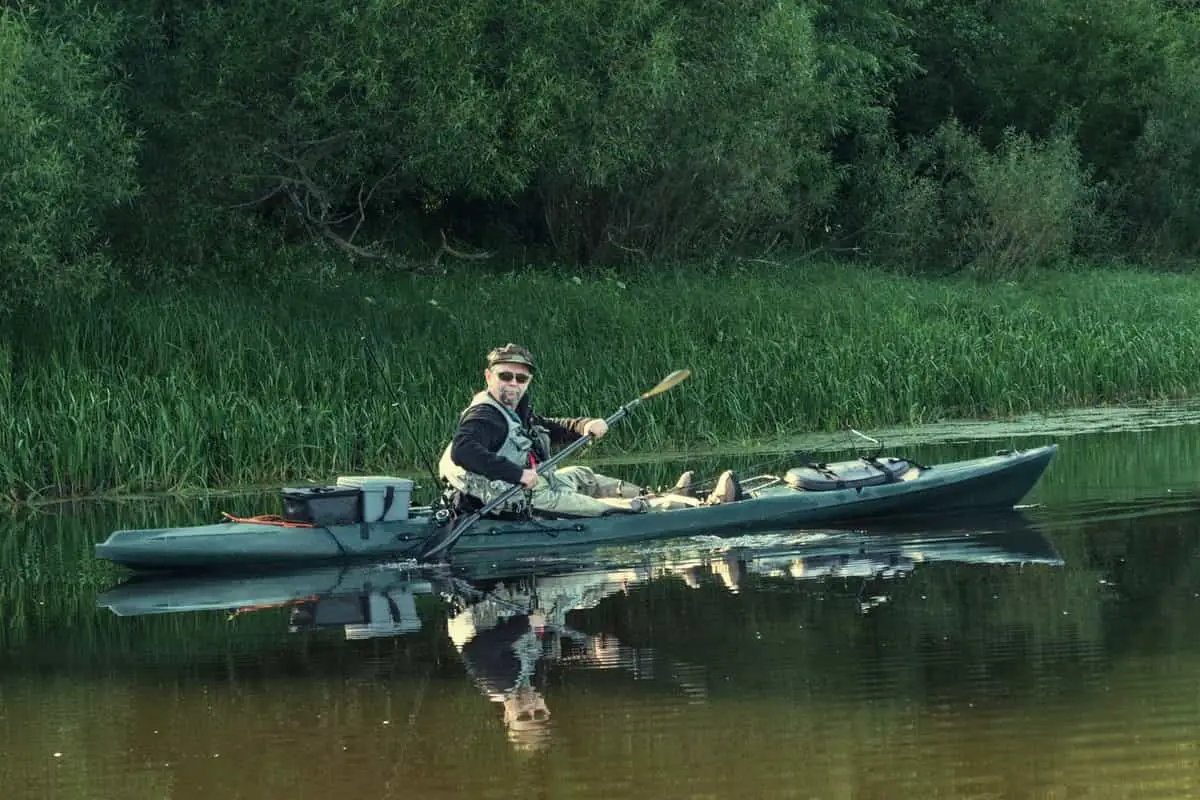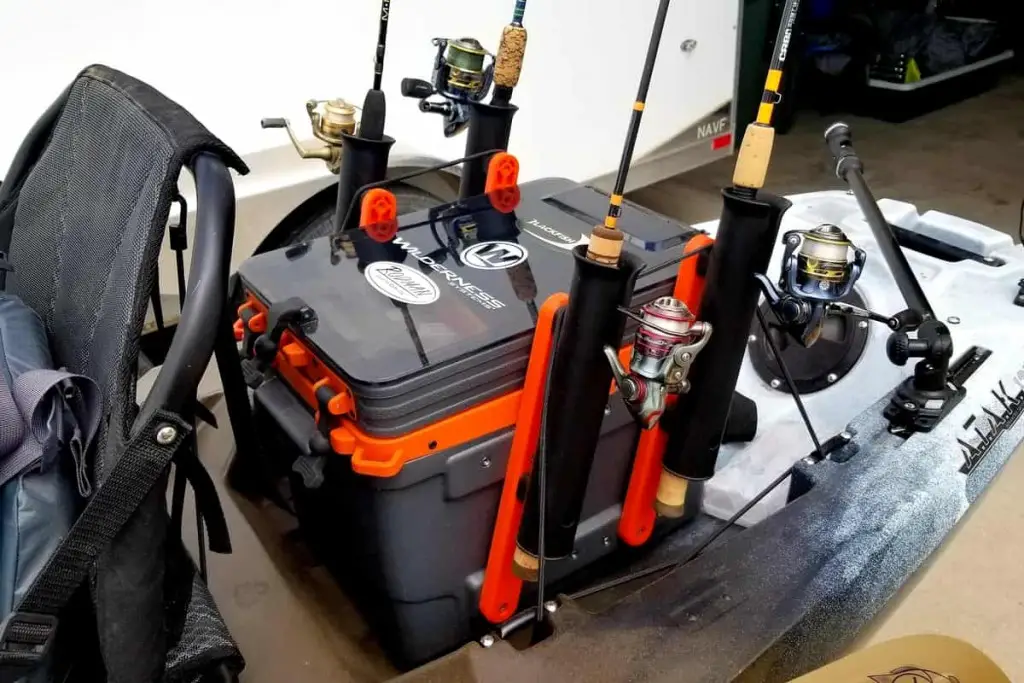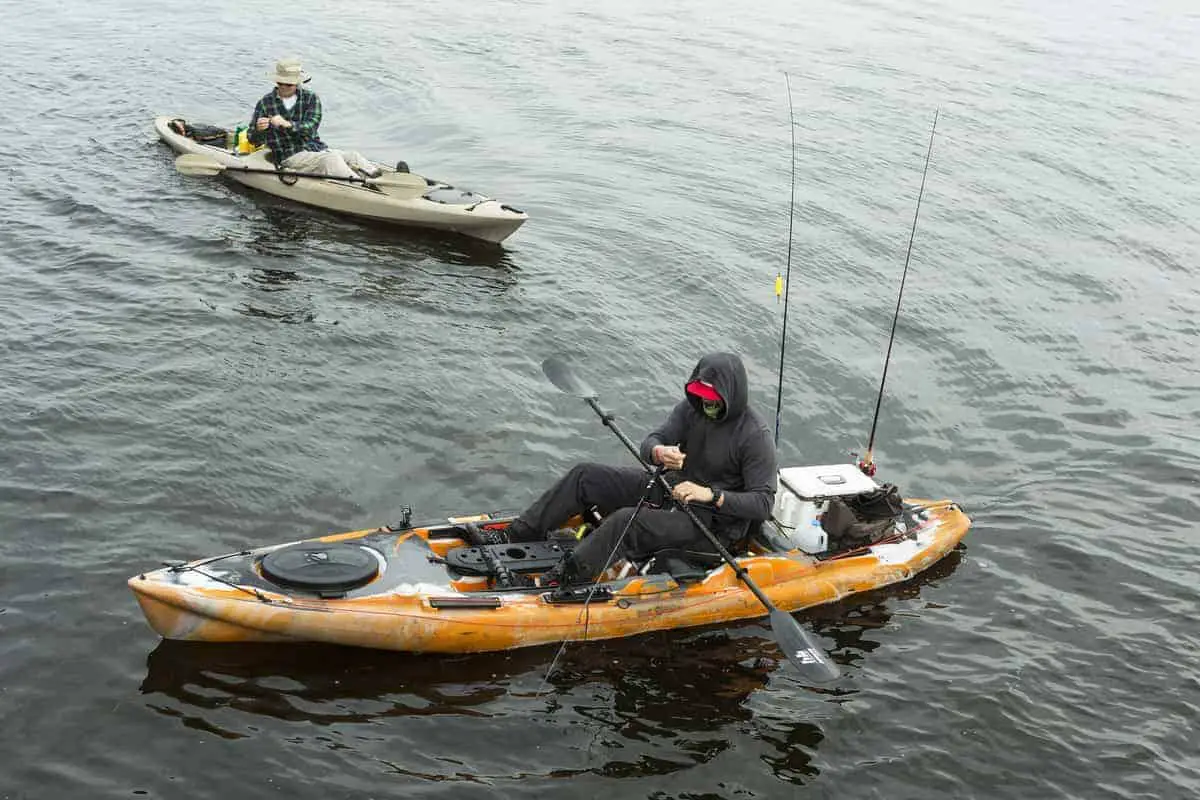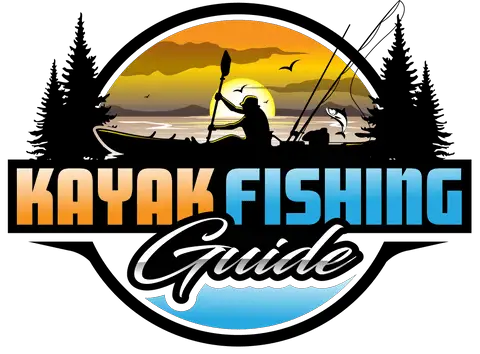The range of modern kayaks available to fish from gives us choices, which means we can choose the best kayak for our fishing preferences and styles. When do we consider the sit-in and sit-on style kayaks, and which would be the best for fishing?
A sit-on-top kayak is better than a sit-in kayak for fishing and has more advantages. It is more stable, has adjustable seats and plenty of storage, drains water quickly, and allows you to walk or move around. A sit-in kayak can be confining, difficult to exit from if flipped, and harder to reenter on the water.
Whatever you decide to choose, each has its strong points and weaknesses. Although the sit-on-top kayaks are more popular and my personal choice to fish from, plenty of people choose a sit-in kayak.
Is A Sit-On Kayak Or A Sit-In Kayak Better For Fishing?
Fishing from a kayak can open up a whole new world of fishing and expand your fishing possibilities. Fishing from a kayak is also tons of fun, and if you enjoy kayaking as much as you enjoy fishing, you can combine the activities and have twice the fun on the water!

When purchasing a kayak for the express purpose of using it for fishing, there are a few characteristics of each type of kayak that you might want to know about to make the correct kayak choice for your needs.
Let’s examine the characteristics of sit-on and sit-in kayaks from a fishing perspective, and it will become apparent to you which type of kayak would suit you the best!
Fishing Kayak Stability
Stability is an important characteristic to consider when selecting a kayak for fishing. You want a stable platform so you do not have to worry about your balance or the kayak tipping over while you are casting or fighting your fish.
Sit-On Kayak Stability
Sit-on kayaks are significantly wider than most sit-in kayaks. This gives them better initial stability when climbing into or exiting the kayak.
A sit-on-top kayak also raises your center of gravity. A higher center of gravity is one reason these kayaks need to have a wider or broader hull.
This wider hull and the high center of gravity are great for flat, calm water. Still, when the water becomes a little rough and choppy, you can feel a little unstable on a sit-on kayak, especially if the swells become high and choppy because you are sitting higher in the kayak.
For more information on kayak stability read my article: How Stable Is a Fishing Kayak?
Sit-In Kayak Stability
The sit-in kayak has less initial stability on the water, making it more challenging to maintain balance when getting into and out of it.
However, the lower center of gravity gives the sit-in kayak superior secondary stability, making it more maneuverable and stable when turning the craft and easier to stay upright in rough water.
The narrower hull makes sit-in kayaks easier to paddle with less effort and quicker on the water than their sit-on counterparts.
At the same time, speed is generally not a concern when fishing. Rough water may be a concern if caught on open water during a storm. You would be happy to be in a sit-in kayak in this case.
While the initial stability may seem like a problem, you can learn to overcome these difficulties and compensate for the balance issues on flat water, which soon becomes second nature.
Maneuverability and a low center of gravity are two reasons whitewater kayakers predominantly use sit-inside kayaks for their adventures!
Ease Of Learning To Kayak
When you are fishing from the kayak, you need to feel as comfortable aboard your kayak as possible. Then, you can focus your attention on fishing rather than kayaking.
If you will fish from any kayak, you must learn how to paddle it. Just like learning to ride a bike, a learning curve is associated with getting comfortable in your kayak.
Sit-On Kayak Ease Of Learning
Sit-on kayaks are the easiest type of kayak to quickly learn the basic skills of kayaking and fishing, especially in calmer, flat water. The skill with these types of kayaks comes with handling them in rough water.
A sit-on kayak is quicker to learn and more comfortable. It also allows you to fish more easily since you are on a stable platform. Plus, it is more forgiving to the kayaker!
Sit-In Kayak Ease Of Learning
A sit-in kayak will take longer to get your sense of balance in. However, it’s like learning to ride a bicycle! Once you acquire the skill, you can do it without thinking about it.

Learning to be comfortable in a sit-in kayak will definitely take longer than learning to be comfortable in a sit-on kayak.
Kayaking Safety
Safety must be an important part of your mindset whenever you go out on the water.
You don’t want to become one of the statistics of fishing accidents out on the water; it is just not worth it. Both kayaks are safe to use out on the water if you are a competent kayaker and know how to swim.
Never take a kayak out on the water for fishing or other purposes if you don’t know how to swim.
If you haven’t learned or aren’t a strong swimmer, Is Kayak Fishing Safe For Non-Swimmers? 7 Best Tips! might be an article you’d want to check out!
If you are a beginner in a kayak, you should know about the safety aspects of each type of kayak to choose the best one for you.
Sit-On Kayak Safety
A sit-on kayak may not be very stable in rough water conditions, but if you do happen to flip over, a few features of this type of kayak benefit you.
The kayak will not sink since most sit-on kayaks have a sealed hull and scupper holes to drain the water from the kayak!
Learn more about scupper holes: What Are Holes in a Kayak For? Should You Plug Them?
You can use the kayak as a floatation device. Even if you struggle to get back aboard the kayak, you can hang on to it, and it will keep you afloat!
A sit-on kayak is much easier to climb back aboard after falling off than a sit-in kayak, which requires a lot of skill and strength to get right.
Sit-in Kayak Safety
A sit-in kayak has an open hull that you sit inside, and there are no scupper holes to drain any water that gets inside. This means that if you fall out of or flip the kayak, it can fill up with water.
Once the kayak fills with water, it may no longer be a useful floatation device to help you stay afloat, and it could also begin to sink.
If the kayak fills with water, there is no way to empty the boat unless you can stand in the water to tip the water out. This means that you must swim for shore while towing your water-filled kayak or abandon the boat and head for shore.
A sit-in kayak is significantly more difficult to get back aboard after you have tipped over. Getting back in can be done, but it takes a lot of practice and a fair amount of strength.
Kayak Storage Space
Let’s face it: As fishermen, we love our gear, and therefore, we need a place to stow it when we go out fishing in our kayaks.
We take rods, bait, lures, spare tackle, knives, pliers, hook removers, and more, probably enough gear to fill a small garage! And now we need to fit this in a kayak?

When you enter the world of kayak fishing, you need to become a minimalist fisherman. Fishing light means only taking a couple of smaller storage boxes of lures instead of carrying numerous tackle boxes full of lures with you!
Both kayak types have storage space, but you must be able to cut down your gear when fishing.
Sit-On Kayak Storage Space
Most sit-on kayaks, especially those designed specifically for fishing, have a storage compartment or two, but the space in these compartments is limited.
If you intend to keep some of the fish you catch, you will probably need to dedicate one compartment to house a fish bag with ice to preserve your catch and prevent it from spoiling.
This will generally leave you with only one other compartment to stow gear, limiting your options somewhat. Most sit-on kayaks will have straps on top to secure other storage items, such as an ice cooler chest or a live well, to keep your catch fresh.
Here are two related articles that address these issues!
Sit-in Kayak Storage Space
Sit-in kayaks will have open areas in front and behind the kayaker while they are seated. Your legs often block easy access to these items upfront, and the seat makes it difficult to reach behind you.
Also, if you want to keep clothing items or food and drink dry, you may want to invest in a dry storage bag.
While the sit-in kayak allows you to take plenty of gear with you, you can also potentially lose more gear should your kayak flip over.
Protection From The Elements
When you are fishing on the water, you may think it is a lovely sunny day, but the sun can quickly start to cook you.
The wind can pick up while you are out on the water, and if the temperatures are cold, getting wet with the wind blowing may make your fishing trip very uncomfortable.
Protection From The Elements On A Sit-On Kayak
Because you are sitting on top of the kayak, it offers no protection from the elements. You are exposed to the sun and the wind and will get wet in rough water.
The sun’s effect is enhanced when you are out on the water, and you can get a bad case of sunburn in a relatively short time. You will have to protect not only your upper body but also your lower body.
When the wind blows and as evening approaches, you will feel the effects of the cold much quicker being exposed on the top of the kayak.
Protection From The Elements In A Sit-In Kayak
A sit-in kayak offers significantly better protection from the elements than a sit-on kayak. Protection from the water is further enhanced if you seal the opening around you using a spray skirt. A spray skirt prevents water from entering the kayak and wetting your lower body.
A sit-in kayak offers better protection from the sun because you have less of your body exposed to the sun. Wear a long-sleeved shirt and apply sunscreen to your exposed skin.
The windburn is less of a factor with a sit-in kayak since your legs will be inside the kayak. Likewise, water entering into your kayak, combined with the wind, is less likely to be a wind chill issue for you.
Best Kayak For Fishing Recommendation
For fishing, the sit-on-top is the preferred fishing kayak! According to numerous surveys, sit-on-top kayaks are favored by kayak anglers close to a 3:1 margin!
“Another number that clearly demonstrates a sea change in how we fish is the ratio of sit-on-top kayaks versus sit-inside—71 to 29 percent.”
Men’s Journal
Take a look at the advantages and disadvantages of each and decide which kayak is best for you. Both kayaks are great for fishing, so the choice would be your preference.
If you are a beginner, my recommendation would be a sit-on kayak.

Starting with a sit-in kayak may be best when fishing in colder regions or rougher water. I recommend a good dry suit or waterproof clothing for either kayak!
A sit-on-top kayak would be the better choice if your swimming skills are not up to par. You can easily reenter the kayak, and it also has good floatation!
Should You Buy A Kayak For Fishing?
Kayak fishing is a great way to expand your fishing opportunities, and kayaks have numerous advantages over using a normal fishing boat.
- No boat registration fees for paddlers
- Don’t need a license to operate a kayak
- No fuel costs
- Easier to transport
- Easier to launch
- Easier to load up
- Does not disturb the fish
- Reach fishing spots boats can’t access
- Stored easily in a garage
- No expensive storage fees
- No need for expensive insurance policies
Conclusion
If you are reading this article to decide whether you should try kayak fishing or not, then that is an easy question to answer. Just do it! The choice should be which kayak is best for your needs rather than whether you should fish from a kayak or not.
Even if you do other forms of fishing, fishing from a kayak will bring a new dimension to an activity you already enjoy and enhance the experience.
Find a kayak you like and try it. You won’t look back, and you will wonder why it took you so long to explore this kind of fishing adventure!
Have fun, and stay safe out there!
